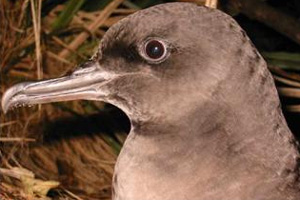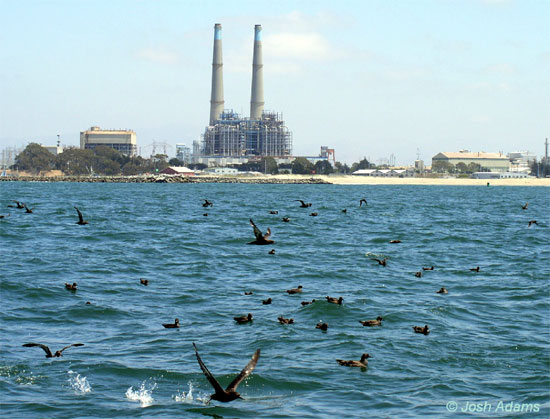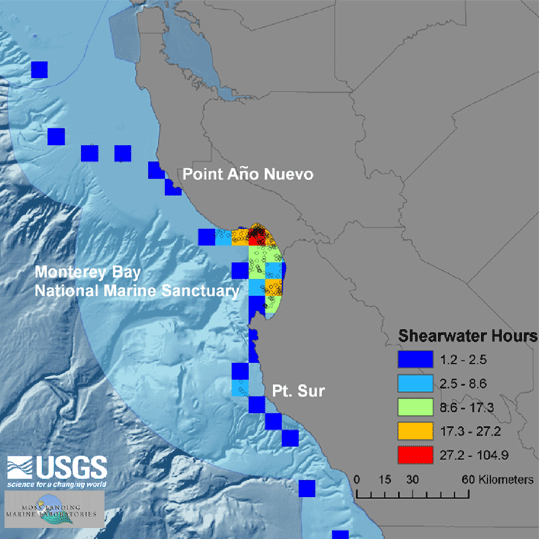
FACTS & TRENDS
- Each year Sooty Shearwaters (Puffinus griseus) travel across the Pacific from breeding colonies in New Zealand and Chile.
- Sooty Shearwaters consume thousands of metric tons of small fishes, such as the northern acnhovy, in Monterey Bay alone.
- Data from this tracking study will help biologists identify important areas of the National Marine Sanctuaries where Sooty Shearwaters aggregate.
Typically, from May through August off central California, moderate northwesterly winds buffet the coastal waters throughout much of the Monterey Bay National Marine Sanctuary. These characteristic winds drive cool nutrient-rich waters to the surface nearshore, reinitiating a foodweb that derives its energy from large phytoplankton blooms stimulated by elevated nutrients and increasing solar radiation. This “upwelling system” supports a large and diverse community of marine vertebrate predators including important commercial fishes, marine mammals, and seabirds—some predators travel thousands of kilometers each year from across the Pacific Basin to feed on abundant forage species such as krill, squid, anchovy, and sardine.
Each year, hundreds of thousands to millions of Sooty Shearwaters (Puffinus griseus) wing their way across the Pacific from breeding colonies in New Zealand and Chile. Off California and throughout the northeast Pacific, sooties are the most abundant seabird predator. Within Monterey Bay, annual consumption by sooties of important prey species like northern anchovy is substantial (thousands of metric tons) – similar to annual harvests reported by commercial seine-net fishers operating primarily from Moss Landing and Monterey harbors. At approximately 20 million individuals, the Sooty Shearwater is one of Earth’s most numerous seabirds. This amazing seabird exists virtually in perpetual spring-summer and completes one of the most extensive annual avian migrations (>28,000 km roundtrip). During April to November, birds depart the southern hemisphere and track high-productivity summer foraging areas in the northern hemisphere including the Japanese to Russian coastal waters, the North Pacific Transition Domain, and the California Current. After molting in July, shearwaters rapidly accumulate fat stores and increase their body mass by ~40% (760 to 1200 g) before initiating trans-Pacific flights to breeding colonies in the southern hemisphere during September to October.
In 2004, during their trans-Pacific migration (http://www.seaturtle.org/tracking/?project_id=46), satellite-tracked shearwaters travelled at about 25 km per hour. Under appropriate wind conditions, shearwaters travel by dynamic soaring-tracing a tilted, sinusoidal path over the waved surface of the ocean. At this rate and travelling along the most direct possible route, a shearwater could leave Monterey Bay (California), traverse the Pacific, and reach New Zealand waters in 16.5 days.
During the summer of 2006, with support from SIMoN, a team of scientists at USGS and Moss Landing Marine Laboratories and several other institutions are continuing a collaborative effort to understand how dominant avian predators interact with the dynamic California Current marine ecosystem. This team has followed the movements and migration of Sooty Shearwaters that visit the network of National Marine Sanctuaries off the US west coast since 2004. Each year, we follow a small number of shearwaters by attaching small computers that “talk” to satellites orbiting the earth. This technology provides us with multiple accurate locations per day for about two to three months while birds within large flocks seek out areas with abundant forage resources. Our goal is to get the inside view of Sanctuary habitats from the perspective of the shearwaters. Because tracking is continuous and unlimited spatially, we can use the data from the tracked shearwaters to map important habitats where assemblage of animals aggregate to forage. With this information we can obtain a fundamental understanding about how physical oceanographic processes and patterns influence these dynamic habitats. Several year’s of tracking will help us understand how shearwaters and their principal prey, respond to variable oceanographic conditions.
As of October 2006 the team is watching as five shearwaters captured on 24 September in central Monterey Bay either seek out local foraging hotspots, or initiate the final leg in their annual migration as they return to spring-time foraging areas in the southern Pacific. As this year is forecast to bring El Niño conditions to the Pacific, these tracking data should provide us insight into the affect of changing global ocean wind patterns on the impressive migration of the Sooty Shearwater.
To access near-real-time data for four satellite tracked shearwaters captured during June in the Monterey Bay National Marine Sanctuary go to
http://www.seaturtle.org/tracking/?project_id=180
Other near-real-time data on satellite tracked animals is available on the Tagging of Pacific Pelagics (TOPP) website at
http://las.pfeg.noaa.gov/TOPP_recent/index.html
More links:
http://birdmam.mlml.calstate.edu/jadams.htm
http://www.oikonos.org/projects/titi.htm

